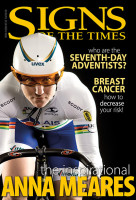Breast cancer claims the lives of more women than most other forms of cancer. In the United States, the incidence of this disease in women is about one in eight, which is nearly 13 per cent, while in Australia and New Zealand it's slightly lower at one in nine (11 per cent).
Breast cancer is an uncontrolled growth of breast cells, a malignant tumour that develops from cells in the breast. Usually breast cancer either begins in the cells of the lobules (the milk-producing glands), or in the ducts that drain milk from the lobules to the nipple. Less commonly, breast cancer can begin in the stromal tissues, which include the fatty and fibrous connective tissues of the breast.
Over time, cancer cells can invade nearby healthy breast tissue and make their way into the underarm lymph nodes, small organs that filter out foreign substances in the body. Cancer cells that penetrate the lymph nodes then have an easy pathway into other parts of the body.
Breast cancer is often caused by a genetic abnormality (a "mistake" in the genetic material). However, only 5 to 10 per cent of cancers are due to an abnormality inherited from one's mother or father. About 90 per cent of breast cancers are due to genetic abnormalities that happen as a result of the ageing process and the wear and tear of life in general, although it can occur at a relatively young age.
Jennifer Reid was only 39 when she was diagnosed with breast cancer, a discovery that stunned her. "I had no family history of this type of cancer at all and up to that point [of diagnosis] I was a very healthy person," she says.
risk factors
In April, researchers at the Walter and Eliza Hall Institute in Melbourne discovered that breast stem cells are very sensitive to oestrogen and progesterone- the two principal hormones in the female body. This discovery explains decades of evidence linking breast cancer risk to exposure to these hormones.
"There is clear evidence that the more menstrual cycles a woman has, the greater her breast cancer risk," said Dr Jane Visvader, who led the research. "There is even an increase in breast cancer risk in the short-term following pregnancy. However the cellular basis for these observations has been poorly understood."
While breast cancer can happen to anybody, there are also a number of risk factors that women can control. These include:
Weight. Being overweight is associated with an increased risk of breast cancer, especially for women after menopause. Fatty tissue is the body's main source of oestrogen after menopause, when the ovaries stop producing the hormone. Having more fatty tissue means one will likely have higher oestrogen levels, increasing the risk of breast cancer. Of course, women should aim to maintain a healthy weight throughout their life for a range of reasons, such as heart health.
Diet. Diet is a suspected risk factor for many types of cancer, including breast cancer, but studies are yet to show for certain which foods increase the risk. It's a good idea to avoid red meat and other animal fats, including dairy products such as cheese, milk and ice-cream, because they may contain inserted hormones, other growth factors, antibiotics and pesticides. A lowfat diet, rich in fruits and vegetables, is recommended.
Lack of exercise. Evidence is growing that a lack of exercise increases the risk of contracting breast cancer while regular exercise reduces the risk. Be moderately active (equivalent to brisk walking) for at least 30 minutes every day.
Alcohol consumption. Studies have shown that breast cancer risk increases with the amount of alcohol a woman drinks. Alcohol can limit the liver's ability to control blood levels of the hormone oestrogen, which in turn can increase risk.
On the other hand, recent research shows that there is a 4 to 5 per cent decreased risk of developing breast cancer for every 12 months that a woman breast-feeds her baby. During breastfeeding, a woman's levels of oestrogen are suppressed, reducing the possibility of developing breast cancer. Women should aim to breast-feed their infants exclusively for at least six months (longer is perfectly OK) and continue with intermittent feeding thereafter.
Unfortunately, there are also various risk factors that one simply cannot control. These are:
Gender. Being a woman is the most significant risk factor for developing breast cancer. Women's breast cells are constantly changing and growing, mainly due to the presence of oestrogen and progesterone, which puts them at a much greater risk for breast cancer.
Age. The risk of developing breast cancer increases with age. A majority of all breast cancers are diagnosed in women 50 years and older, and thus the need for mammograms once you turn 40.
Family history of breast cancer. Women who have a first-degree relative (mother, daughter, sister) who has had breast cancer, or have multiple relatives affected by breast or ovarian cancer (especially before they turned 50), are at a higher risk of developing breast cancer.
Personal history of breast cancer. Women who have already been diagnosed with breast cancer are at a greater risk of developing it again, either in the same breast or in the other breast, than if they never had the disease.
Race. White women are slightly more likely to develop breast cancer than those of other races.
Breast cellular changes. Unusual changes in breast cells found during a breast biopsy (removal of suspicious tissue for examination under a microscope) can be a risk factor for developing breast cancer. These changes include overgrowth of cells (called hyperplasia) or abnormal (atypical) appearance.
prevention
Despite the substantial loss of life from breast cancer, the prospects for survival are better than ever. Deaths from breast cancer have been decreasing worldwide and are thought to be the result of advancement in treatment, earlier detection through screening and increased awareness that can be largely attributed to breast cancer foundations around the world, including the Pink Ribbon movement.
Thanks to research utilising funds raised by organisations like the National Breast Cancer Foundation in Australia, breast-conserving surgery (lumpectomy) with local radiation therapy has replaced mastectomy as the preferred surgical approach for women with early stage breast cancer. Chemotherapy is also a standard treatment for women in early-stage breast cancer. And the introduction of sentinel lymph node biopsy procedures has enabled less-invasive surgical diagnoses and prognoses, resulting in less chronic arm problems for breast cancer sufferers and a better quality of life.
Although there is no known way to completely prevent breast cancer, early detection is by far the best method of reducing deaths from it. The most important thing a woman can do is to have a mammogram, especially for those with no apparent symptoms. Routine mammographic screening is now an accepted standard for the early detection of breast cancer, contributing to reduced mortality.
Women between the ages of 40 and 49 are advised to have a mammogram every year, and once every two years beyond the age of 50. Beginning at about the age of 20, women should be aware of how their breasts look and feel and know what is normal, so that they can identify changes that are new and unusual. While most lumps and changes in breast appearance are not an indication of cancer, some are, and therefore should be checked by a doctor or health professional.
Since 1994, the National Breast Cancer Foundation in Australia has awarded more than $A55 million to research projects covering all aspects of breast cancer. These projects currently include creating a new detection technology that may be better than mammography- and may be as easy as a blood test; as well as developing a breath test to measure substances in the breath that may be very early warnings of breast cancer.
where is God in all of this?
"I have never once believed that God is to blame for my breast cancer. He loves me and only wants the best for me, but because we live in an imperfect world, sickness comes and it just so happened to come to me. I believe that God would not have allowed it if He didn't think my family and I could handle it," says Reid, who has had two surgeries, chemo- and radiation therapy, and will need to undergo various treatments for the next five years.
"My faith in God has been the only thing that I knew for sure would not let me down . . . and that He is with me every single moment. From the devastating minute I found out I had cancer, to the trauma of having to tell my children and my mum, through the horror of chemotherapy and through every fearful thought, God is with me.
"Being a Christian is ultimately all about having hope for the future. Even though I had a fear of dying young and still do sometimes, I don't believe that God is finished with me yet."







